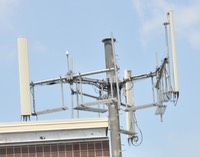Modern data transmission systems combine capacity-approaching error control codes with spectrally efficient modulation to achieve a desirable tradeoff between energy- and bandwidth-efficiency. In collaboration with Dr. Xingyu Xiang [J23], we have developed a coded-modulation system that is particularly well suited for satellite channels. The system, described in my presentation at Georgia Tech, combines APSK modulation, constellation shaping, optimized LDPC codes, and iterative processing to achieve a gain of over 1 dB compared to the DVB-S2 standard. In collaboration with Dr. Don Torrieri, Dr. Shi Cheng, and Dr. Rohit Seshadri, we have developed coherent [J18], noncoherent [J13], differential [J14], and multi-symbol [J20] receivers and code designs for coded continuous-phase modulation (CPM). A key contribution in this work is the use of information theory to jointly optimize the coding and modulation parameters for the particular channel and receiver. Other issues of interest include noncoherent modulation and receiver design for the two-way relay channel [J22], the effect of finite block lengths [C57], and the constellation labeling problem [J17]. To assure that the results are reproducible, we have released the software used by this research as an open source library --- the Coded Modulation Library (CML). CML contains implementations of many common coding and modulation schemes, including those used by the LTE, WiMAX, and DVB-S2 standards. Among my presentations, you can find several tutorials on modern error correcting codes, including LDPC codes and the codes used in the IEEE 802.16e WiMAX standard. I still maintain a web page on turbo codes, which was one of the first web pages devoted to turbo codes.
Matthew C. Valenti
Professor, Lane Department of Computer Science and Electrical Engineering
Copyright 2010-2022 Matthew C. Valenti
